10 Best Claw Hammers of 2024 – Top Picks & Reviews
-
- Last updated:


Few tools are as versatile as the ordinary claw hammer. Equally adept at creation and destruction, claw hammers can breathe life into a project or completely dismantle it with just a couple of swings. You’ll rarely see a toolbelt that isn’t loaded with one.
Hammers might be the earliest of all hand tools. Archaeologists discovered primitive stone hammers in Kenya that date back 3.3 million years! Of course, the hammers we use today are far from outdated stone-age technology. Modern hammers are well-balanced, offer excellent leverage, and even have additional features built-in to increase their usefulness.
If you’ve been to a home improvement store recently, you know there are hundreds of hammers. So, how are you supposed to pick just one? You can start by reading the following 10 reviews that will compare some of the best and see how they stack up.

A Quick Comparison of Our Favorites in 2024
| Rating | Image | Product | Details | |
|---|---|---|---|---|
Best Overall
 |
 |
Estwing E3-16S Claw Hammer |
|
CHECK PRICE |
Best Value
 |
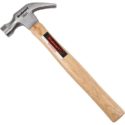 |
Stalwart 75-HT3000 Hardwood Claw Hammer |
|
CHECK PRICE |
Premium Choice
 |
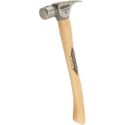 |
Stiletto FH10C Claw Hammer |
|
CHECK PRICE |
|
|
 |
IRWIN 1954889 Claw Hammer |
|
CHECK PRICE |
|
|
 |
Best Choice Stubby Claw Hammer |
|
CHECK PRICE |
The 10 Best Claw Hammers
1. Estwing E3-16S Claw Hammer – Best Overall

Hammers lead difficult lives that consist of getting their heads bashed in daily. They need to be robust and durable to endure such an existence, which is why the Estwing E3-16S Claw Hammer is forged as a single piece of solid steel. The handle and head are all one piece, ensuring no weak points in the design. This makes for an incredibly strong hammer, though it also causes it to ring like a tuning fork when you strike it.
To ensure that your bones don’t ring like the hammer from each impact, a shock-absorbing grip reduces 70% of impact vibrations. This hammer features a rip claw that allows you to yank boards apart, remove nails, and perform other demolition tasks. On the other side of the head, the smooth face is perfect for finish work and isn’t as likely to mar if you accidentally hit something you didn’t mean to.
Luckily, Estwing’s hammers are protected against failure from normal use. Unless you decide to throw this hammer off skyscrapers, it might be the last one you ever need to purchase. All these reasons and more make this the best overall claw hammer on the market this year.
- Forged as a single piece of solid steel
- The rip claw is incredibly versatile
- Shock absorbing grip reduces 70% of impact vibrations
- Smooth face is great for finish work
- Warrantied against failure from normal use
- It rings like a tuning fork
2. Stalwart 75-HT3000 Hardwood Claw Hammer – Best Value

A tool doesn’t have to be expensive to deliver quality, as proven by the Stalwart 75-HT3000 Hardwood Claw Hammer. It’s priced much more affordably than most competitors, though it’s still loaded with great features that we think make it one of the best claw hammers for the money.
For instance, the anti-vibration handle is carved from natural hardwood and helps reduce the impact you feel from each strike. It’s polished, so it looks and feels nice, though it’s not as sturdy as other hammers we’ve tested, and it wouldn’t be our top choice for heavy professional use.
Stalwart’s hammer has a curved claw that’s great for pulling nails, though it’s not the best choice for demolition work. Opposite the claw, the face is smooth, so it’s less likely to mar if you miss a nail and hit your material instead. Overall, it’s a great deal for the price, and we’re confident you’ll agree.
- Priced affordably
- Anti-vibration handle reduces impact
- Smooth hammer face is less likely to mar
- The wooden handle isn’t the most durable
3. Stiletto FH10C Claw Hammer – Premium Choice
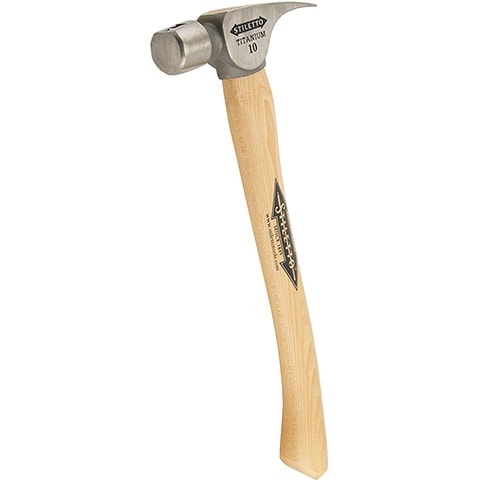
It’s hard to avoid getting sticker shock when looking at a hammer that costs almost 10 times as much as some of the competition. But the Stiletto FH10C Claw Hammer is one of the most impressive hand tools we’ve used.
It’s well-built and feels very solid, with a head crafted from titanium. The head weighs just 10 ounces, but it has the driving power of a 16-ounce hammer, saving your muscles. It also absorbs most of each impact, thanks in part to the hickory handle that absorbs much of the shock.
The only downside to the Stiletto is that it’s not intended for banging on hardened steel tools like chisels that can dent the titanium head. For professionals who rely on their hammer daily, the Stiletto is built to hold up. Moreover, it’ll help you get more out of your work since it spares your joints and muscles with each strike.
- The head is crafted from titanium
- Hickory handle transfers less shock than steel
- The head weighs 10 ounces, sparing your arms
- Has the driving power of a 16-ounce hammer
- Saves your muscles and joints
- Wildly expensive
- Not intended for hitting hard steel tools
4. IRWIN 1954889 Claw Hammer
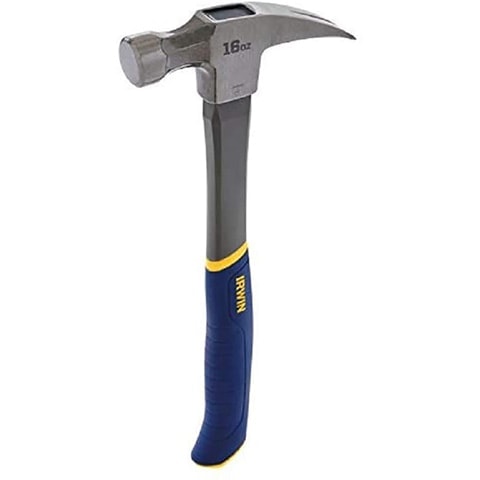
When a tool is protected for life, like the IRWIN Claw Hammer, you know it’s a well-built tool you can rely on. But that’s not the only great thing about this hammer. It has a durable forged steel head with a smooth face that’s less likely to mar any surfaces you hit accidentally. Unfortunately, it’s not as hard as we’d like. Ours had several dents from hard impacts, particularly against steel tools like chisels.
Banging a hammer around all day can put pressure on your joints and bones. Luckily, this hammer has a vibration-absorbing fiberglass handle that doesn’t transfer as much impact. The ProTouch grip reduces impacts even further and provides great grip so the hammer never slips.
One big complaint we have with this tool is how the head and handle are joined. They’re glued together with epoxy. For light-duty use, this is fine. But if your hammer is going to be abused, we’d recommend looking for one that’s more durable.
- Priced affordably
- Smooth face is less likely to mar
- Vibration-absorbing fiberglass handle with ProTouch grip
- Warrantied for life against normal use
- Epoxy joined head and handle
- Soft steel head dents from hard impacts
5. Best Choice Stubby Claw Hammer

Not every hammer is intended for building homes or destroying them. Take the Best Choice Stubby Claw Hammer, for instance. At less than 7 inches long, you can safely call this tool tiny. But if you just need a hammer for hanging a picture frame on occasion, it is perfect. Its small size makes it easy to store, but you might lose it in the junk drawer!
If you’ve ever accidentally hit your thumb instead of the nail head you were aiming for, you’ll appreciate the magnetic nail holder built into the hammer. It will hold your nail straight so that you can get it started without the need for holding it with your other hand.
The Best Choice hammer has a curved claw that’s great for pulling nails. With a hammer this size, even if it were a rip claw, it wouldn’t be good for much else. Don’t expect to build or demo anything serious with this hammer. It’s made from a soft alloy that won’t withstand abuse. But if you need a tiny tool to stash away for the rare moments you need it, this hammer is the perfect candidate.
- Compact size takes up no space
- Curved claw for maximum leverage when pulling nails
- Magnetic nail holder for starting nails with one hand
- The stubby design has limited usefulness
- Soft alloy steel doesn’t hold up to rough use
6. CRAFTSMAN CMHT51399 Claw Hammer

Sometimes, you need a bit more oomph behind your swing, which is where the 20-ounce head on the CRAFTSMAN CMHT51399 Claw Hammer comes into play. The extra weight gives you more power and leverage when driving large framing nails. Likewise, you’ll have more power to drive the rip claw into boards for removing them and pulling things apart.
Of course, there’s a downside to the extra weight. It might give you more power, but it also takes more energy and wears you out quicker. You’ll also notice that this hammer is a bit more expensive than many competitors, which is likely because of the 20-ounce head.
Still, you can’t complain about some features, such as the lifetime warranty that protects it. We also liked the overstrike protection on the handle near the head. This reinforces the hammer in the critical area where you’re most likely to make an impact if your swing misses. Thanks to this feature, you’re much less likely to need that warranty, but we still like the peace of mind it provides.
- The handle is reinforced in problem areas
- Protected by a full lifetime warranty
- 20-ounce head provides plenty of striking force
- The extra weight can wear you out faster
- More expensive than similar hammers
7. Dewalt Dwht51048 Rip Claw Hammer

DeWalt is one of the most trusted names in tools, and we’ve used many of their products with great success over the years. Unfortunately, the DeWalt 51048 Rip Claw Hammer didn’t meet our expectations. It’s more expensive than the competition by a wide margin, so we had high hopes when we started using it, but they were quickly dashed.
First, we noticed rough edges inside the claw that made it difficult to pull nails. The claw is straight, like a rip claw, but it’s too short to be useful. For us, this is a significant oversight.
Still, there were aspects of this hammer we liked. It has a built-in nail start system that allows you to start nails with one hand. The face is also smooth, making it less likely to leave marks if you miss. We also liked the weight distribution, but there were simply too many flaws to get past.
- Built-in nail start system
- Great weight distribution increases your leverage
- Smooth-faced, so it won’t mar
- Rough edges inside the claw
- Far more expensive than the competition
- Claw is too short for demo and not curved enough for nail-pulling
8. Edward Tools Oak Claw Hammer
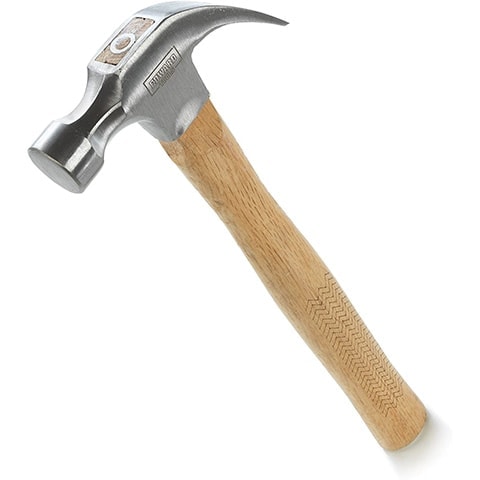
We like affordable tools, so we hoped that the Edward Tools Oak Claw Hammer would be a winner since it’s one of the cheapest hammers we tested. Despite the low price, it has excellent features like a contoured anti-vibration handle made from solid oak and a lifetime warranty that protects this tool.
But the downsides vastly outweighed the positives when we started using it. The head is forged carbon steel, but it wasn’t securely attached to the handle. It was loose right out of the box, which didn’t instill confidence.
The handle had two stickers on it when the hammer arrived. We removed them, but they left sticky glue all over the handle. Then, we noticed on the first swing that the hammer is unbalanced. It just doesn’t feel good to use. That was the last straw for us, which is why this hammer is ranked so low on our list.
- Dirt-cheap pricing
- Contoured anti-vibration solid oak handle
- Covered by a lifetime warranty
- The head wasn’t completely secure
- Stickers left the handle covered in glue
- It’s not well balanced
9. TEKTON 30123 Jacketed Fiberglass Claw Hammer

The TEKTON Jacketed Fiberglass Claw Hammer is built with an impact-resistant fiberglass handle that saves your joints and bones from the jarring impact of metal on metal. Depending on your needs, it’s available with either a flattened or curved claw.
On paper, this tool looks great. In person, it leaves a lot to be desired. To begin with, the head is bonded to the handle with epoxy, which is a very weak attachment method. Ours started coming loose pretty quickly. All it took was a few hard impacts, and they were beginning to separate.
We were certain the head would come off soon but were surprised when the handle broke instead! It occurred right below the head in the thinner part of the handle. Obviously, this presents a danger, so we can’t recommend this hammer.
- Available with a flattened or curved claw
- Impact-resistant fiberglass handle
- The Head is bonded to the handle with epoxy
- The head is damaged easily and becomes loose
- The weak handle is prone to breakage
10. Stanley STHT51346 Curve Claw Fiberglass Hammer

This Stanley hammer is more expensive than most competitors, but we’ve had good luck with Stanley tools in the past, so we decided to give it a chance. It has great features we loved, such as the Stanley lifetime warranty that protects the tool for life. We also liked the reinforced overstrike protection plate that absorbs missed hits.
But for the price, we were hoping for a better product. The hammer is smaller than it appears. When you hold it, it feels undersized, making it difficult to get a comfortable, secure grip. It’s nearly an inch shorter than most of the other hammers we tested, and you can feel the lack of leverage when you’re trying to get power behind your swing.
The worst flaw with this hammer is that the head is attached with epoxy. After only a few hours of use, the head began getting loose. We didn’t want to give it the chance to come off and cause an injury, so we left it. There are much better hammers available for the price, so we don’t recommend this one.
- Stanley lifetime warranty
- Overstrike protection plate absorbs missed hits
- More expensive than the competition
- Small size doesn’t provide as much leverage
- The head is attached with epoxy

Buyer’s Guide – Choosing the Best Claw Hammer
From hanging pictures to building homes, hammers can be used for various tasks. However, some hammers are better suited for specific tasks than others. So, how do you decide on a single hammer to trust?
After using and abusing dozens of hammers on hundreds of projects, we’ve whittled the list of features down to the most important ones you need to consider before purchasing a hammer. If you keep these things in mind, you’re sure to get a hammer that’s perfect for your needs.
Weight
Hammers come in a wide range of weights and sizes, though most fall between 8-42 ounces. Lighter hammers are smaller, easier to wield, and won’t wear you out as quickly. On the other hand, they don’t provide as much leverage or strength.
Driving long nails is difficult with a light hammer, but you’ll have a much easier time driving finish nails since the lighter hammer is less likely to bend them. Heavier hammers will wear you out more and take up more space on your toolbelt or your toolbox. But they also provide a lot more power. Driving long nails requires a heavier hammer, but a heavy hammer can easily bend finish nails.
For claw hammers, the average size is 16 ounces, and almost every hammer on this list was a 16-ounce hammer, with just a few exceptions. In general, it is a great all-around weight for most tasks. However, if you’re doing framing work, you’ll want a heavier hammer closer to 20 ounces. If you only hang picture frames, a light hammer is ideal.
Materials
When you compare hammers, one of the biggest differences between models is the materials they’re made from. Every part of the hammer can be made from different materials, including the head, handle, and how they’re attached.
Handle
Often, you’ll see handles that are made from either wood or fiberglass. Both materials absorb vibrations and reduce the amount of impact that you feel.
Wooden handles are usually polished or etched. Fiberglass handles are usually wrapped with an additional layer of rubber that provides improved vibration dampening and gives you a better grip.
Some hammers feature a metal handle that’s the most durable of all. These hammers are usually forged into a single piece, strengthening the area where hammers are most likely to break, right below the head.

Head
Steel is The most common material used to make a hammerhead. Generally, it’s drop-forged and hardened to endure repeated abuse. Some hammers use a steel alloy instead. You’ll often find this on small hammers like stubbies that aren’t intended for hard use.
Other hammers that occupy the top of the price range feature titanium heads. They are excellent at absorbing impacts and can save your joints and bones. However, they’re not great if you need to hit steel tools like chisels since they can dent the titanium.
Attachment
There are several methods for attaching the head to the handle. The most durable hammers are a single piece of forged steel. Other hammers use epoxy to glue the head onto the handle. This is the weakest method of attachment, and we’ve had the heads come off of several hammers that were constructed with adhesives.
Some hammers with wooden handles use a metal wedge inserted inside the wood to pressure fit it to the handle. They are much stronger and more secure than epoxied handles.

In Conclusion
A good hammer is an investment that will keep paying you back for years. You might have already decided on the right one after reading our reviews, but if you’re still on the fence, we will review our top picks of the best claw hammer once more.
The Estwing E3-16S Claw Hammer is our number one pick. It’s durable since the entire tool is forged as a single piece of solid steel and even warrantied against failure. The shock-absorbing grip reduces 70% of impact vibrations, saving your arms and prolonging your energy.
When you want a quality tool at a budget price, we recommend the Stalwart 75-HT3000 Natural Hardwood Claw Hammer. It has a drop-forged steel head with an anti-vibration handle, and it’s one of the most affordably priced models we tested.
For professionals who need premium tools and are willing to spare no expense, we suggest the Stiletto FH10C Claw Hammer. It has a 10-ounce titanium head with the driving force of a 16-ounce hammer with a shock-absorbing hickory handle, which spares your joints and muscles so you can keep working for longer.
See Also:
- What are the Must-Have Tools for an Aspiring Handyman?
- Corded hammer drills: what are they, and which product do we recommend?
- Hammer Drill vs Impact Driver – What’s the Difference?
- What are SDS hammer drills?
Featured Image Credit: Pixabay
Contents

